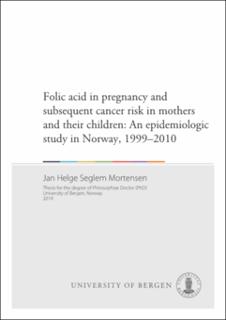| dc.description.abstract | Background: Observational studies and randomized trials have shown that maternal folic acid supplementation before and during early pregnancy decreases the risk of neural tube defects in offspring. Hence, women of fertile age are advised to use folic acid supplements before and during early pregnancy, and food fortification programs with folic acid have been introduced in many countries. There is concern about the safety of folic acid supplementation in relation to cancer risk. However, despite this concern, previous studies on cancer are inconsistent and the association between folic acid and cancer is weak. Norway and many other countries have information campaigns to increase periconceptional folic acid use among women planning pregnancy. Studies have shown an association between maternal social and demographic characteristics and maternal periconceptional folic acid use. However, little is known whether there is an association between social and demographic characteristic of the woman’s partner and her folic acid use in the periconceptional period. Objectives: To investigate the cancer risk (in total and for specific sites) for the mother after folic acid supplementation before and/or during pregnancy. To investigate the overall risk for childhood cancer and for major childhood cancer types after in utero exposure to maternal supplemental folic acid. To investigate if selected paternal characteristics are associated with maternal use of folic acid in pregnancy. Material and methods: All live-born children in Norway during 1999–2010, as well as their mothers and fathers, were identified by the Medical Birth Registry of Norway and defined as the study populations (687,406 children, 429,004 mothers, 434,686 fathers, and 683,785 childbirths). We identified maternal and childhood cancer cases by linkage to the Cancer Registry of Norway, with follow-up until a cancer diagnosis, emigration, death, or the end of 2010. The study population was also linked to the National Registry, the Norwegian National Education Database, and the Norwegian Labour and Welfare Administration. Cancer risk among women using folic acid supplements prior to and during one and two or more pregnancies were compared to cancer risk in women not using such supplements. Cancer risk in children exposed in utero to maternal folic acid and/or multivitamin supplements were compared to cancer risk in children whose mothers never used supplements. The associations between folic acid use and cancer risks were estimated as hazard ratios (HRs) with 95% confidence intervals (CIs) using Cox proportional hazard regression models. The association between recommended maternal folic acid use (before and during pregnancy) and paternal age, education, occupation, and country of origin was estimated as relative risks (RRs) with 95% CIs using log-binomial regression with robust error variances. Results: From 1999 through 2010, 3,781 mothers developed cancer. The mothers were followed for an average of 7 years (range 0.04–12 years), constituting 2,933,587 person-years. No increased risk was seen for total cancer among women using folic acid in one (HR 1.08; 95% CI 1.00–1.18) or two or more pregnancies (HR 1.06; 95% CI 0.91–1.22) (pTrend = 0.12). No specific subtypes of cancer showed increased risk. Altogether, 799 children developed cancer during follow-up. The mean follow-up time was 6 years (range 0.04–12 years), constituting 4,052,679 person-years. We found no association between any supplemental folic acid levels and risk of leukemia (e.g., high-level folic acid HR 1.25; 95% CI 0.89–1.76, pTrend 0.20), lymphoma (HR 0.96; 95% CI 0.42–2.21, pTrend 0.51), central nervous system tumors (HR 0.68; 95% CI 0.42–1.10, pTrend 0.32), neuroblastoma (HR 1.05; 95% CI 0.53–2.06, pTrend 0.85), Wilms’ tumor (HR 1.16; 95% CI 0.52–2.58, pTrend 0.76), or soft-tissue tumors (HR 0.77; 95% CI 0.34–1.75, pTrend 0.90). During 1999–2010, the mothers used folic acid supplements before and during pregnancy, as recommended, in about 16% of all births in the study population. Recommended maternal folic acid use was low among mothers whose partners were young (e.g., <20 years RR 0.35; 95% CI 0.28–0.43) or older (e.g., ≥ 40 years RR 0.72; 95% CI 0.71–0.74), had attained a lower educational level (RR 0.69; 95% CI 0.68–0.71), fitted the occupational classes other than “Higher professionals,” and originated from low/middle-income countries (RR 0.58; 95% CI 0.56–0.60). Conclusion: There was no association between folic acid supplementation before and/or during pregnancy and short-term risk of maternal and childhood cancer. A longer observation of our study population may have increased the statistical power of our analyses. Despite official recommendations and information campaigns aimed at fertile women in Norway, periconceptional folic acid supplementation is insufficient. Our study demonstrates that recommended periconceptional folic acid use was lower when fathers were among the youngest and oldest, had shorter education, were selfemployed or worked in manual occupations, or originated from low/middle-income countries. | en_US |
